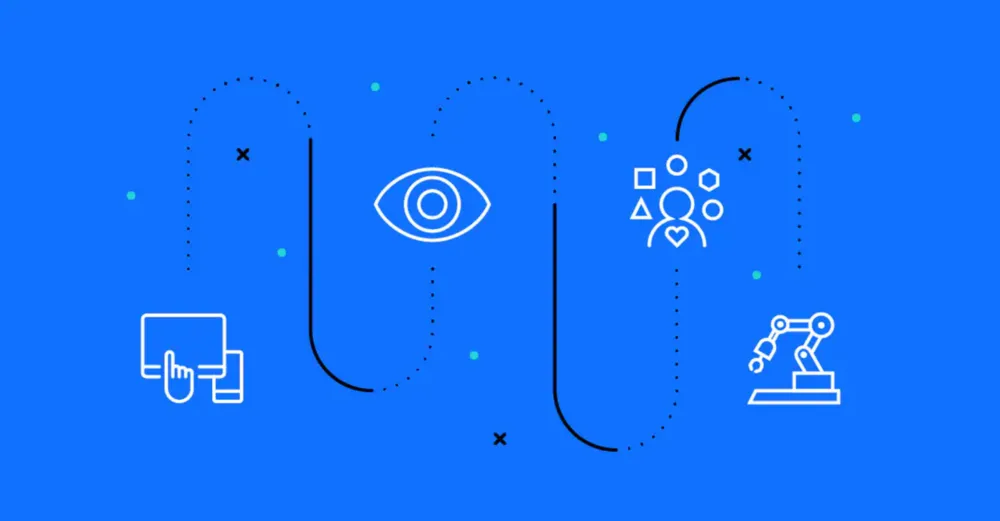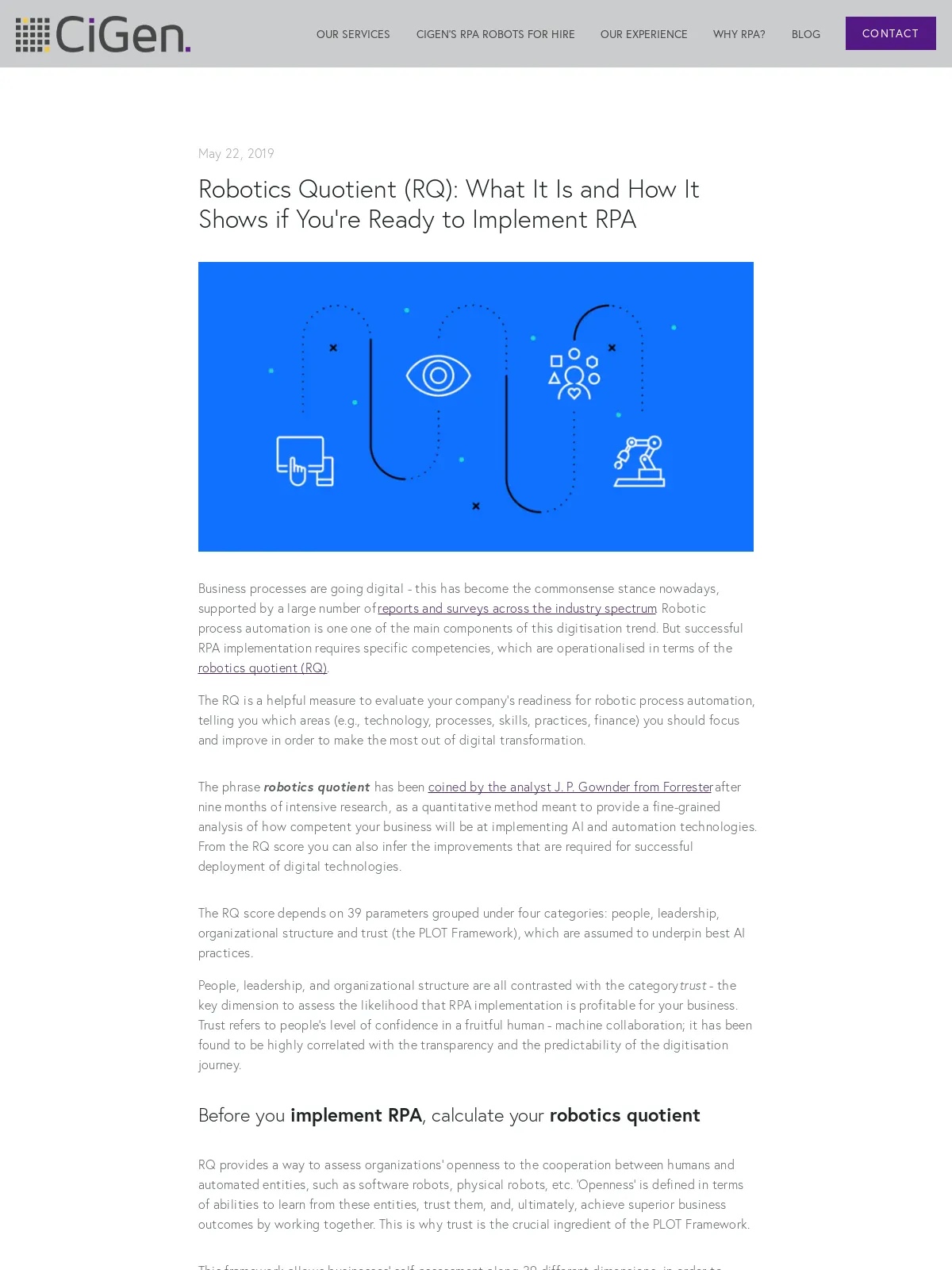Robotics Quotient (RQ): What It Is and How It Shows if You’re Ready to Implement RPA
Blog: Cigen

Business processes are going digital - this has become the commonsense stance nowadays, supported by a large number of reports and surveys across the industry spectrum. Robotic process automation is one one of the main components of this digitisation trend. But successful RPA implementation requires specific competencies, which are operationalised in terms of the robotics quotient (RQ).
The RQ is a helpful measure to evaluate your company’s readiness for robotic process automation, telling you which areas (e.g., technology, processes, skills, practices, finance) you should focus and improve in order to make the most out of digital transformation.
The phrase robotics quotient has been coined by the analyst J. P. Gownder from Forrester after nine months of intensive research, as a quantitative method meant to provide a fine-grained analysis of how competent your business will be at implementing AI and automation technologies. From the RQ score you can also infer the improvements that are required for successful deployment of digital technologies.
The RQ score depends on 39 parameters grouped under four categories: people, leadership, organizational structure and trust (the PLOT Framework), which are assumed to underpin best AI practices.
People, leadership, and organizational structure are all contrasted with the category trust - the key dimension to assess the likelihood that RPA implementation is profitable for your business. Trust refers to people’s level of confidence in a fruitful human - machine collaboration; it has been found to be highly correlated with the transparency and the predictability of the digitisation journey.
Before you implement RPA, calculate your robotics quotient
RQ provides a way to assess organizations’ openness to the cooperation between humans and automated entities, such as software robots, physical robots, etc. ‘Openness’ is defined in terms of abilities to learn from these entities, trust them, and, ultimately, achieve superior business outcomes by working together. This is why trust is the crucial ingredient of the PLOT Framework.
This framework allows businesses’ self-assessment along 39 different dimensions, in order to identify the areas that ought to be improved and the organizational skills that must be either acquired or further developed. The analysis within the PLOT Framework yields two RQ scores, one for the current state, and another one for a desired state which can be plausibly attained in 6 to 12 months.
In what follows, we’ll look at each of the four categories of PLOT.
People
The theoretical background of people’s assessment is derived by application of Daniel Goleman’s tenets regarding emotional intelligence to human-machine interactions. Emotional intelligence has five key elements, namely self-awareness, self-regulation, motivation, empathy and social skills.
Other features that are considered when measuring people are digital literacy, openness to lifelong learning, and ambition to stay up to date with technological developments.
All in all, the better able are human employees to understand, adapt to, and hence - collaborate with non-human coworkers by exchanging data and insights with them, the higher the company’s RQ score.
Leadership
Leaders of organizations are the ones who are called to harmonize the digitisation perspective with the organization’s adaptive potential and with people’s confidence that the effort invested in these changes is worth it.
As a consequence, for a company to be ready to implement RPA, it is highly important that the leader’s traits are attuned to the digital era. An example of such a trait is adaptability, understood as the capacity to integrate novelty flexibly, yet maintaining the capacity to follow the established rules in a non-arbitrary manner.
For instance, adaptable leaders will be better able to effectively integrate in a consistent automation project inherent modifications of the objectives that occur along the way. Leaders’ progressive dynamism and their capacity to contribute to building employees’ trust in automation, would raise the RQ score and speak in favour of the company’s readiness to implement RPA.
Thank you! An expert will contact you soon.
Organizational structure
At the organization level, digitisation requires an infrastructure that allows performance of superior processes, devising new roles and titles for the employees’ (e.g., bot manager), and including these roles in the organizational chart.
The provision of training and mentoring opportunities is a precondition for extending the chart with new positions. The clearer and the more formalized are the organizational changes that lead to fulfilling this set of prerequisites, the smoother the path towards successful RPA implementation.
All in all, RQ scores showing that a company is prepared to go digital depend on the establishment of new structures and processes, well suited with an automated workflow.
Trust
People’s baseline level of trust varies proportionally with specific traits of the robotic systems, such as transparency or determinism. The more transparent and deterministic a system, the easier it is for people to understand its whys and wherefores and to anticipate its behaviour, hence the more they tend to have confidence in it.
Because of intrinsic differences between various digital technologies with respect to the dimensions of transparency and determinism, the first predictor of trust is the type of technology.
Last but not least, we wish to pinpoint the fact that employees’ trust in the effectiveness of their interactions with automated devices must be built by proper education, augmenting the baseline degree of trust.
Given the pervasiveness of the ‘robots will steal our jobs’ mentality and of the consequential technology-related anxiety, ill-founded as these may be, people’s mistrust in digitisation can be taken as a starting assumption. Hence no efforts should be spared in making it clear to your employees that people will be displaced only from the tedious, repetitive tasks that everybody actually dreads, and that subsequent upskilling is likely to increase job satisfaction.
Conclusion
The robotics quotient provides objective answers to questions about the ability of your organisation to handle the challenges of automation and AI, and about your employees’ readiness to learn, adapt and work alongside digital entities.
It is a measure that helps you decide whether non-human coworkers can be fruitfully co-opted into attaining your financial and managerial objectives. It also shows what you should be doing in order to maximise the likelihood of people and robots successfully working together.
Now that you are aware of the factors that modulate your company’s preparedness for leveraging RPA, where do you think you’re standing? Even more importantly, what could you do to increase the RQ score and thus come one step closer to the starting line of a lucrative automation journey? We are here to help you find the answers and thus implement RPA proficiently. Contact us and we will work it out together.
